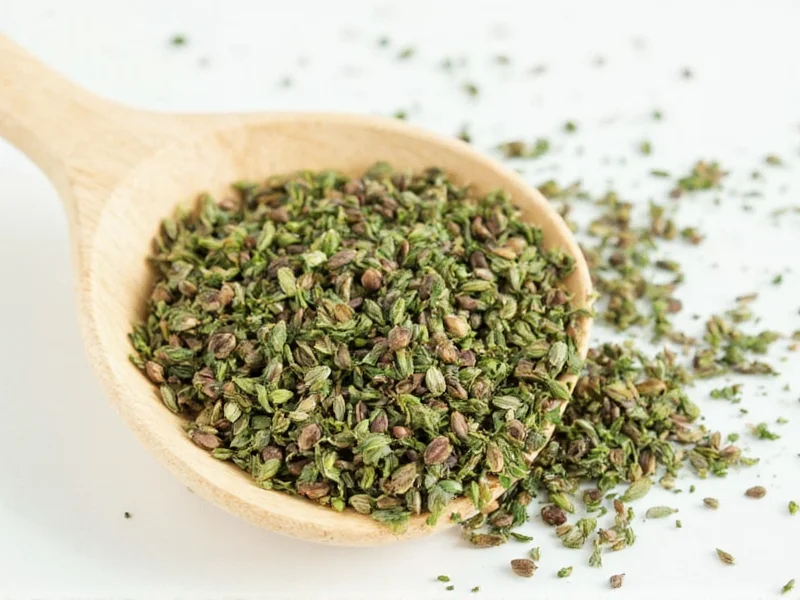When adapting recipes that call for fresh thyme, knowing how to substitute dried for fresh thyme properly is essential for balanced flavor development. The 1:3 dried to fresh ratio serves as your foundational guideline, but several factors influence optimal substitution in different cooking contexts.
Why Dried and Fresh Thyme Aren't Interchangeable
Thyme undergoes significant chemical changes during the drying process. Fresh thyme contains approximately 85% water, which evaporates during drying, concentrating the essential oils and flavor compounds. This concentration explains why you need less dried thyme than fresh. The volatile oils responsible for thyme's distinctive aroma and flavor become more potent when water content decreases.
Understanding how to substitute dried thyme for fresh requires recognizing that dried thyme delivers a more earthy, slightly medicinal flavor profile compared to fresh thyme's brighter, grassier notes. This difference matters most in delicate dishes where herb flavor plays a starring role rather than supporting character.
Precision Substitution Guide for Different Cooking Methods
The basic 1:3 ratio provides a starting point, but optimal substitution varies based on your cooking technique. Consider these adjustments when determining how to replace fresh thyme with dried in your specific application:
| Cooking Method | Standard Ratio | Adjustment Tips |
|---|---|---|
| Long-simmered dishes (stews, soups) | 1 tsp dried : 1 Tbsp fresh | Add dried thyme early; flavors mellow during cooking |
| Quick-cooked dishes (sauces, sautés) | 3/4 tsp dried : 1 Tbsp fresh | Add dried thyme later; potency remains more intense |
| Raw applications (salad dressings, garnishes) | 1/2 tsp dried : 1 Tbsp fresh | Reconstitute dried thyme in warm liquid first |
| Baking (breads, pastry fillings) | 5/8 tsp dried : 1 Tbsp fresh | Mix with dry ingredients to distribute evenly |
Flavor Balancing Techniques When Substituting
Mastering the art of substituting dried thyme for fresh requires more than just measurement conversion. Consider these professional techniques to achieve balanced flavor:
- Rehydration method: For raw applications, combine dried thyme with 1 teaspoon of warm water or broth per teaspoon of herb and let sit for 10 minutes before using
- Layering approach: In long-cooked dishes, use 75% of your calculated dried thyme amount during cooking and add the remaining 25% at the end
- Acid balancing: Dried herbs often benefit from a splash of acid (lemon juice or vinegar) to brighten their more earthy profile
- Taste testing protocol: Always wait 15-20 minutes after adding dried thyme before final seasoning adjustment, as flavors continue to develop
Quality Considerations for Optimal Substitution
Not all dried thyme performs equally in substitution scenarios. The age and quality of your dried thyme significantly impact the effectiveness of the dried thyme to fresh thyme conversion:
Fresh thyme typically maintains peak flavor for 1-2 weeks when properly stored, while dried thyme gradually loses potency over time. High-quality dried thyme retains about 60-70% of its original flavor compounds for 6-12 months when stored in an airtight container away from light and heat. Older dried thyme may require slight ratio adjustments—up to 25% more—to achieve equivalent flavor intensity.
When determining the best way to replace fresh thyme with dried, check your dried thyme's quality by rubbing a small amount between your fingers. It should release a strong, pleasant aroma. If the scent is faint or musty, replace your supply before attempting substitution.
Recipe-Specific Substitution Guidance
Certain dishes require special consideration when making the switch from fresh to dried thyme. Understanding these nuances ensures your substitution enhances rather than detracts from your culinary creation:
- Roasted meats: Use the standard 1:3 ratio but rub dried thyme under the skin rather than on the surface for better flavor penetration
- Vegetable dishes: Reduce dried thyme by 25% compared to the standard ratio to prevent overpowering delicate vegetables
- Fish preparations: Use only half the standard dried thyme amount, as fish has more delicate flavor profiles
- Tomato-based sauces: Increase dried thyme by 10-15% to compensate for tomatoes' acidity which can mute herbal flavors
Common Substitution Mistakes to Avoid
Even with the correct dried thyme measurement for recipes, several pitfalls can compromise your results:
- Adding dried herbs too late: Unlike fresh herbs which can be added at the end, dried herbs need time to rehydrate and release flavors—add them at least 20 minutes before dish completion
- Overcompensating for freshness: Never double the dried thyme amount thinking it will match fresh thyme's volume—this creates bitter, medicinal flavors
- Ignoring recipe moisture content: In very dry recipes (like rubs), increase liquid by 1-2 teaspoons per teaspoon of dried thyme to facilitate flavor release
- Using pre-ground dried thyme: Whole dried thyme leaves retain flavor significantly better than pre-ground versions for substitution purposes
Storage Recommendations for Maximum Potency
Proper storage directly impacts how effectively you can substitute dried for fresh thyme. Follow these guidelines to maintain your dried thyme's substitution viability:
- Store in airtight glass containers away from light, heat, and moisture
- Keep whole dried leaves intact until ready to use (crush just before adding to recipes)
- Label containers with purchase date and use within 12 months for optimal substitution accuracy
- Store away from strong-smelling spices to prevent flavor transfer











 浙公网安备
33010002000092号
浙公网安备
33010002000092号 浙B2-20120091-4
浙B2-20120091-4